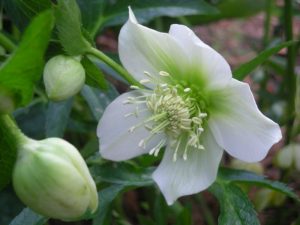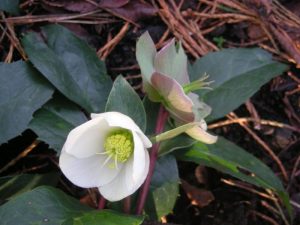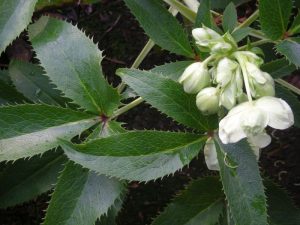Helleborus orientalis, collected in Turkey by E.K. Balls, is now to be found growing in the upper Woodland Garden. This is a showy clump with fresh, white flowers and as with most hellebores, the sepals fade a shade of green once all the flower parts drop, leaving the prominent stigmas pointing outwards. In hellebores, the petals have become modified to act as nectaries. These appear as the inner ring within the sepals, looking like a multitude of green shovel heads. Also see the variable strain ‘Winter Queen’ in the Copse.
Growing in the same bed is H. x ericsmithii, a sterile hybrid, the result of crossing H.niger x H.sternii (itself a cross between: argutifolius x lividus) The leaves are etched wine red as is the reverse mid rib. White sepals and fresh yellow flower parts clustered are within. The outer of the sepal is mottled, replicating the colour of the leaves. Again, the colours fade as the sepal shape changes to resemble a green shield. Many forms of this cross are in cultivation some with superior leaf marbling and flower colour shades.
It is named after Eric Smith, a plant breeder and selector who in the 1950s worked at Hilliers nursery, Winchester and later in partnership during the 1970s at the now closed Plantsman Nursery in Dorset. Now there is a term to conjure with – plant selector: someone with an eye for detail able to appreciate diversity. The ability to spot the potential in a variation of leaf shape, intensity of colour or muted shade, the form or appearance that appeals and appears different to the usual batch. The term plant selector underestimates the eye this man had for spotting and then the skill to nurture and grow on for distribution the many selected forms of plants during his lifetime.
Botanic gardens throughout the world are the custodians for much of the biodiversity within the plant kingdom. They are now bound by the terms of the Convention on Biological Diversity (CBD), which came into force on 29 December 1993, following the UN Rio Conference of 1992. Its principle objective is the conservation and sustainable use of biological diversity. Each of the 188 signatories is to develop national strategies based on this objective. It provides for the fair and equitable sharing of benefits arising from its implementation and should allow a country to retain the “intellectual rights” of plants collected within its political boundaries.
The raw material for this is held within the seed capsule. Plant collectors should not make commercial use of wild collected material without those countries government’s knowledge and approval.
H. argutifolius, a native to Corsica and Sardinia, is a tall bruiser of a plant growing in the quadrangle and also in the Rhododendron Walk. The glossy green leaves are edged with an intricate pattern of spines, facing forward, not dangerous in the least. The flowers are borne in a terminal clump of a very light green. The anthers and filaments almost spiral back into the sepals as the bud opens. After flowering has finished, these shoots can be cut out, giving space for new growth to break out from the perennial rootstock.




1 Comment
1 Pingback